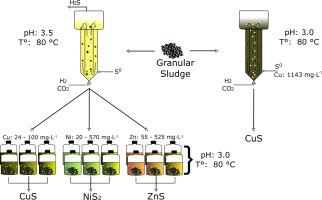Hydrometallurgy ( IF 4.8 ) Pub Date : 2022-08-12 , DOI: 10.1016/j.hydromet.2022.105950 Adrian Hidalgo-Ulloa , Cees Buisman , Jan Weijma

|
Biological sulfidogenic systems are advantageous over hydroxide precipitation methods to recover base metals from hot and acidic metallurgical streams. Sulfide precipitation is not widely used in the hydrometallurgical industry for the high operational and capital expenses associated with compartmentalizing the sulfidogenic and metal precipitation process. A single-stage elemental sulfur-reducing process in which sulfidogenesis and metal precipitation occur concurrently could significantly decrease these costs. This study examines the effect of metals on the sulfidogenic activity of an adapted thermoacidophilic sulfur-reducing culture. Batch tests were conducted with Cu2+, Ni2+, and Zn2+ in concentrations up to 100, 570, and 525 mg L−1, respectively. All metal ions were completely precipitated (LOQ < 0.1 mg L−1) with higher volumetric sulfide production rates than in the experiments without metals. Dissolved metals appear to stimulate the sulfur reduction metabolism in a redox-dependent process. Additionally, we investigated the use of an unadapted microbial inoculum from a full-scale anaerobic reactor as a fast start-up inoculum for a sulfidogenic process under high temperature (80 °C), low pH (pH 3), and high Cu2+ concentrations (up to 1143 mg L−1). After seven days of operation, we found equivalent sulfidogenic rates to those obtained after 75 days of adaptation with the same inoculum. These results encourage the development of a single-stage metal precipitation and sulfur-reducing process under conditions suitable for thermoacidophilic microorganisms.
中文翻译:

来自全尺寸厌氧反应器的元素硫还原嗜酸微生物培养物介导的金属硫化物沉淀
生物硫化系统在从热和酸性冶金流中回收贱金属方面优于氢氧化物沉淀法。硫化物沉淀在湿法冶金工业中没有广泛使用,因为与分隔硫化和金属沉淀过程相关的高运营和资本费用。硫化生成和金属沉淀同时发生的单阶段元素硫还原过程可以显着降低这些成本。本研究考察了金属对适应的嗜热酸性硫还原培养物的硫化活性的影响。使用浓度高达 100、570 和 525 mg L -1的 Cu 2+、Ni 2+和 Zn 2+进行批量测试, 分别。与没有金属的实验相比,所有金属离子都完全沉淀(LOQ < 0.1 mg L -1),具有更高的体积硫化物产率。溶解的金属似乎在依赖氧化还原的过程中刺激硫还原代谢。此外,我们研究了使用来自全尺寸厌氧反应器的未适应微生物菌剂作为高温 (80 °C)、低 pH (pH 3) 和高 Cu 2+条件下硫化过程的快速启动菌剂。浓度(高达 1143 mg L -1)。操作 7 天后,我们发现与使用相同接种物适应 75 天后获得的硫化率相当。这些结果促进了在适合嗜热嗜酸微生物的条件下开发单阶段金属沉淀和硫还原工艺。









































 京公网安备 11010802027423号
京公网安备 11010802027423号